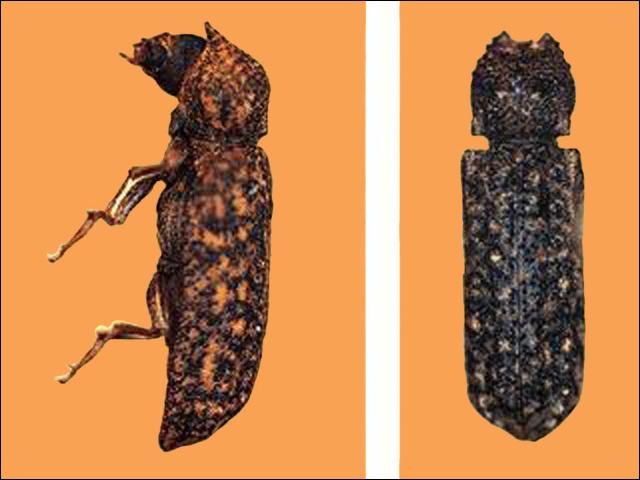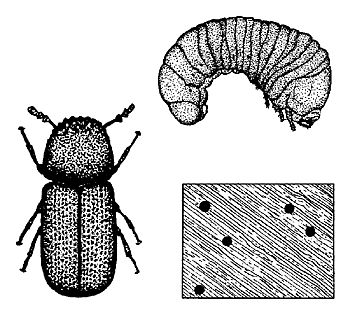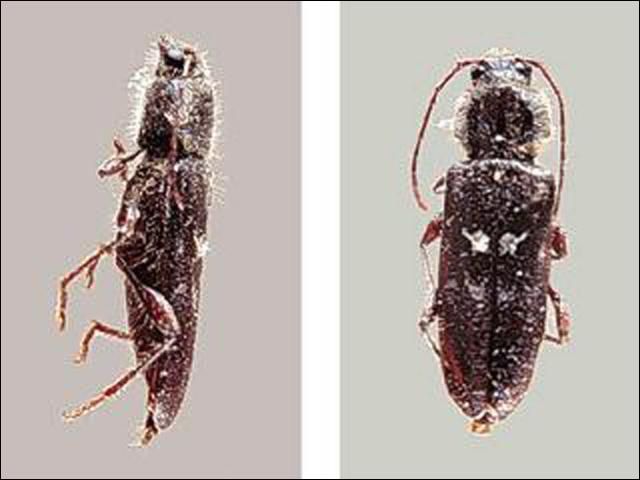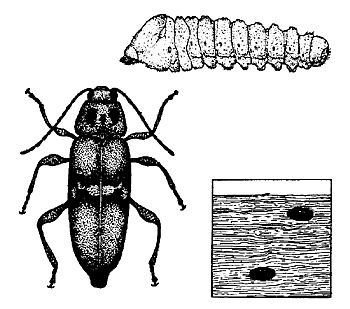Powderpost beetles can be serious pests of structures and wooden contents such as bookshelves, tables, and decorations. The larvae of these beetles live in and consume dry, seasoned wood. The most common types of powderpost beetles are anobiine, lyctine, and bostrichid beetles. Other wood-infesting pests are old house borers and carpenter bees. This publication explains how to recognize powderpost beetles and other wood-infesting pests as well as their damage to wooden structures.
Anobiine Powderpost Beetles (family Ptinidae)
Anobiine powderpost beetles (Figure 1) are usually about 1/16 to 1/4 inch long and reddish brown or grayish brown to dark brown. The body is cylindrical, elongated and covered with fine hair. The head is covered by the pronotum from top view. The last three segments of antennae are usually lengthened and broadened. The larvae are white, C-shaped grubs with rows of small spines on the dorsal side (Figure 2). The beetles' life cycle lasts one to 10 years, depending on the species. Anobiine powderpost beetles infest seasoned softwood and the sapwood of seasoned hardwoods.

Credit: James Castner, UF/IFAS

Credit: UF/IFAS
Most commonly, infestations of Anobiine powderpost beetles are found in structural timbers made of softwood, such as beams, sills, joists, studs, subflooring and plywood. In addition, Anobiines will infest hardwood furniture, wall paneling, window and door molding, hardwood floors, and furniture. Woods such as maple, beech, poplar and pine are especially susceptible to attack. The optimal wood moisture content for development is 13% to 30%. Infestations develop slowly, but wood can be reinfested year after year.
Signs of Infestation
The key to avoiding serious problems with Anobiine powderpost beetles is early detection and control. Usually, homeowners see the damage rather than the beetles. The larval damage occurs entirely below the surface of the wood, where larvae eat tunnels. This damage is not usually seen until the wood disintegrates. However, the adults emerge from the wood, leaving emergence holes and powderlike frass with some pellets that sifts from the holes.
Emergence holes from Anobiines are 1/16 to 1/8 inch in diameter and round. Cigarshaped frass is found loosely in tunnels and in small mounds outside of emergence holes. The frass is powderlike but feels gritty.
Bostrichid Powderpost Beetles
Bostrichid powderpost beetles (Figure 3) are 1/8 to 3/4 inch long and reddish brown to black. Their bodies are elongated and cylindrical with a roughened thorax. Heads are concealed by the pronotum from above. The antennae are short with three or four enlarged, serrated terminal segments. The larva is white and C-shaped with no spines on the body (Figure 4). The life cycle is one year. Bostrichids infest seasoned softwood and hardwood, especially unfinished floors, windowsills, and furniture. Bamboo items are especially susceptible to attack by some species of Bostrichid beetles.

Credit: James Castner, UF/IFAS

Credit: UF/IFAS
Signs of Infestation
The round emergence holes are 1/8 to 3/16 inch in diameter. Sawdustlike frass sticks together and is found tightly packed in galleries but not in entrance holes.
Lyctinee Powderpost Beetles (family Bostrichidae)
Lyctine powderpost beetles (Figure 5) are about 1/4 inch long and brown. The body is elongated and slightly flattened. The head is prominent and not covered by the pronotum. Antennae have a two-segmented terminal club. The larvae are white and C-shaped, with the eighth abdominal spiracle enlarged (Figure 6). This beetle's life cycle is six months to four years.

Credit: James Castner, UF/IFAS

Credit: UF/IFAS
Lyctine infest the sapwoods of hardwoods—mainly ash, hickory, oak, maple, and mahogany. Consequently, most infestations are found in wood paneling, molding, window and door frames, hardwood floors, and furniture. Imported tropical hardwoods are especially infested with Lyctids because of poor storage and drying practices prior to shipment to the United States. Joists, rafters, and subfloors of houses are not usually infested with Lyctids, because they are usually made of pine or other softwoods.
Lyctine rarely infest wood older than five years. Therefore, infestations are usually in new homes or newly manufactured articles. Infestation usually results from wood that contained eggs or larvae at the time of purchase. Typically the item was made from wood that was improperly dried or stored.
Old House Borer
The larvae of the old house borer (a long-horned wood boring beetle—Cerambycid) (Figure 7) sometimes infest softwoods. The adult beetle is grayish-black and 1/2 to 3/4 inch in length, with several white markings on the wing covers and with long antennae. The female lays eggs in crevices of logs or timbers. The larvae hatch and require three to five years or more to mature. The larvae are 1/2 to 11/2 inches long and are white, segmented, and have an enlarged, brownish head (Figure 8). They bore through the wood, making irregular galleries. During quiet times, their feeding may be heard as a clicking or rasping sound. The beetles emerge through an oval hole about 1/4 to 3/8 inch in diameter.

Credit: James Castner, UF/IFAS

Credit: UF/IFAS
Signs of Infestation
The key to avoiding serious problems with old house borers is early detection and control. Usually, homeowners see the damage rather than the beetles. The larval damage occurs entirely below the surface of the wood where larvae eat tunnels. However, their frass occupies more space than the volume of wood that is consumed. Therefore, they fill the tunnels in the wood completely, causing a blistering or rippled effect. The frass is a fine, powderlike dust that is found loosely packed in tunnels and in small piles outside of the hole. The frass is extremely fine and feels like talc but usually has small pellets of frass mixed with it. Adult emergence holes are oval and 1/4 to 3/8 inch in diameter.
Control of Powderpost Beetles and Old House Borers
There are several options for control of powderpost beetles and old house borers. Selecting the best option depends on a number of factors, such as the severity of infestation, the location of infestation, potential for reinfestation, and cost of treatment. Powderpost beetles and old house borers damage wood slowly, so there is plenty of time to make a decision on control options. Always followed label directions when pesticides are selected as a control option.
Prevention. Most beetle problems are introduced into homes in lumber or finished wood products such as furniture, paneling, or flooring. Most serious infestations occur when infested wood is installed in the house. Inspect wood to insure nsure that wood is not infested at the time of home construction.
Wood finishes. Powderpost beetles lay eggs only on bare, unfinished wood. Beetles are less likely to infest wood that is painted, varnished, waxed, or similarly sealed. Beetles emerging from painted or varnished wood were either in the wood before finishing or were a result of reinfestation by eggs that were laid in emergence holes of adult beetles.
Wood replacement. Infested wood can be replaced if the infestation appears to be localized. For instance, if emergence holes appear in a member of a door or window frame, the piece can be removed and replaced with a new, uninfested wood.
Surface treatment. Insecticides, particularly borates formulated with glycols, are labeled for surface treatment of bare, exposed wood. Glycols increase penetration into the wood. Spraying or brushing insecticides onto infested wood creates a barrier that kills adult beetles as they chew their way out of wood. The barrier also kills newly hatched larvae as they attempt to bore into wood. For the surface treatments to work properly, they must penetrate the wood. Therefore, the wood should be unfinished or sanded to remove the finish. In certain situations, the surface treatment can penetrate the wood sufficiently to kill larvae within the wood to prevent the further marring of the surface by additional emergence holes of adults.
Fumigation. Fumigation is considered the most effective method of controlling wood-boring beetles. However, fumigation can be the most costly method of control and does not provide residual protection of the wood. Only pest control operators certified to apply fumigants can do fumigation work. Fumigation of infested furniture or small articles like picture frames and baskets can be done without fumigating the entire structure. Some pest control operators will fumigate infested furniture inside fumigation chambers at their business so that the entire building does not need to be tented and fumigated.
Carpenter Bees
Carpenter bees (Figure 9) are 3/4 to 1 inch long and closely resemble bumble bees, except that their abdomen is a shiny metallic greenish-black, and the abdomen of bumble bees is very hairy. These insects sometimes build their nests in solid wood such as weather boarding, railings, supports, and trim of buildings. Their nests are in the form of tunnels 3 to 6 inches deep in the wood. The entrance hole is about 1/2 inch in diameter. The holes are very clean and appear as though they were made by a drill.

Credit: Paul M. Choate, UF/IFAS
Control
Carpenter bees can be controlled by removing and replacing infested wood. Painting, staining, or filling holes with putty does not usually prevent the bees from digging a new tunnel. Insecticides can be used to treat areas of wood where carpenter bees are active.